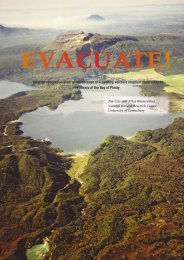Tsunami evacuation: Lessons from the Great East Japan earthquake ...
Tsunami evacuation: Lessons from the Great East Japan earthquake ...
Tsunami evacuation: Lessons from the Great East Japan earthquake ...
You also want an ePaper? Increase the reach of your titles
YUMPU automatically turns print PDFs into web optimized ePapers that Google loves.
2012<br />
Generally maps appear quite crowded with a range of topographic, cultural as well as<br />
tsunami <strong>evacuation</strong> related content. In some cases additional historic event lines are present<br />
as well as coloured zones. However, <strong>the</strong> location of at least one tsunami hazard zone stands<br />
out well in all maps.<br />
All of <strong>the</strong> <strong>evacuation</strong> maps that we observed show refuge locations although, <strong>the</strong> symbols<br />
used are inconsistent between maps. Definitions of refuges vary and include generic ‘safe<br />
refuge’, ‘tsunami-specific refuge’, ‘vertical <strong>evacuation</strong> building’ (Figure 11) or ‘welfare<br />
location’s, with some maps using different symbols to define refuge type. Many of <strong>the</strong><br />
refuges shown on maps were designated based on community function and capacity and<br />
were typically schools or community centres. During <strong>the</strong> <strong>evacuation</strong> on March 11th many<br />
people evacuated directly to designated shelters.<br />
There is limited illustration of <strong>evacuation</strong> routes on <strong>the</strong> maps. Ōfunato (Figure 10) and<br />
Kesennuma (Figure 11) use arrows indicating <strong>the</strong> approximate best route out of <strong>the</strong><br />
inundation zone, but <strong>the</strong>re is no prescriptive route marked. O<strong>the</strong>r maps do not include any<br />
graphical indication of <strong>evacuation</strong> route.<br />
Text-based <strong>evacuation</strong> or preparedness information is provided on most maps, but <strong>the</strong><br />
content of this information varies. The Tarō Town map includes information on previous<br />
tsunami events, while <strong>the</strong> maps for Ōfunato and Natori have advice on preparedness and<br />
space for residents to fill out important information.<br />
The interviews carried out in this study did not provide sufficient insight into <strong>the</strong> impact of<br />
inconsistent <strong>evacuation</strong> maps on <strong>evacuation</strong> on March 11 th 2011. This requires fur<strong>the</strong>r<br />
research as <strong>Japan</strong> amends and enhances its hazard modelling and <strong>evacuation</strong> mapping in<br />
light of <strong>the</strong> Tōhoku tsunami. Recent work by Kurowski et al. (2011) highlighted that some<br />
similar inconsistencies occur in <strong>evacuation</strong> mapping in Washington and Oregon (see Section<br />
1.5), and any research in <strong>Japan</strong> into <strong>the</strong> impacts of variable <strong>evacuation</strong> maps on <strong>the</strong><br />
response of transient populations or different levels of risk perception in <strong>Japan</strong>ese coastal<br />
communities could provide additional guidance as to enhancing <strong>the</strong> approach taken in<br />
Washington. Consistency in <strong>evacuation</strong> mapping is already recognised as an issue in <strong>the</strong><br />
United States and all maps produced after January 1st 2012 are subject to guidelines set out<br />
by <strong>the</strong> NTHMP Mitigation and Education Subcommittee (2011) to ensure minimum<br />
requirements in <strong>evacuation</strong> mapping. Updating of current maps to ensure consistency is<br />
expected to be complete by <strong>the</strong> end of 2012 (J. D. Schelling, personal communication,<br />
March 9th 2012).<br />
Consistent <strong>evacuation</strong> mapping in New Zealand is being achieved by following <strong>the</strong><br />
guidelines set out in MCDEM (2008a). Some variation still exists in terms of <strong>the</strong> delineation<br />
of <strong>the</strong> location of <strong>evacuation</strong> zone boundaries, where local CDEM group members are<br />
responsible for producing <strong>the</strong>ir own mapping of zones <strong>from</strong> hazardous wave heights e.g.<br />
Hawke’s Bay CDEM Group (2011). In New Zealand <strong>the</strong>re is a strong emphasis on simple<br />
maps showing zones, routes and safe locations, and as concise as possible messaging<br />
focussing on <strong>the</strong> required response to natural and informal warnings (evacuate all zones) vs.<br />
official warnings (<strong>the</strong> warning will state <strong>the</strong> zone(s) to evacuate). One community group, in<br />
conjunction with Wellington Emergency Management Office, has delineated <strong>the</strong> beginning of<br />
<strong>the</strong> mapped safe zone with a blue line painted across roads throughout <strong>the</strong> suburb. This has<br />
generated very high public awareness and is planned to be rolled out city-wide.<br />
GNS Science Report 2012/17 15

















